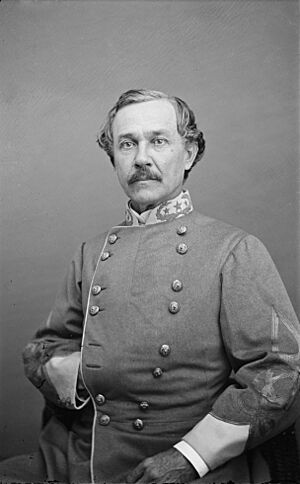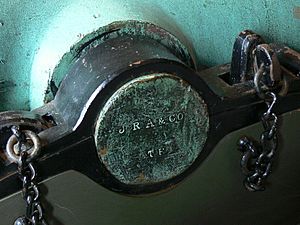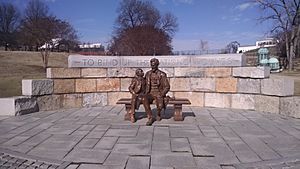Tredegar Iron Works facts for kids
|
Tredegar Iron Works
|
|
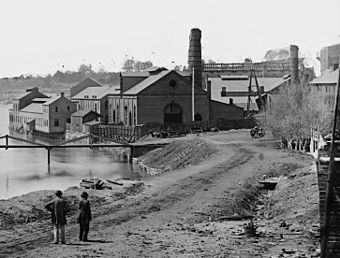
Tredegar Iron Works, Richmond, Virginia, U.S., photograph by Alexander Gardner
|
|
| Location | Richmond, Virginia |
|---|---|
| Built | 1841 |
| Architect | Reev Davis |
| NRHP reference No. | 71001048 |
Quick facts for kids Significant dates |
|
| Added to NRHP | July 2, 1971 |
| Designated NHLD | December 22, 1977 |
The Tredegar Iron Works in Richmond, Virginia, was a very important factory during the American Civil War. It was the biggest ironworks in the Confederacy. Its importance helped make Richmond the capital of the Confederacy.
Tredegar made about half of all the cannons used by the Confederate States Army. It also made the iron plates for the CSS Virginia, which was the first Confederate ironclad warship. This ship fought in the famous Battle of Hampton Roads in March 1862. The factory was saved from being burned down during the evacuation of Richmond. It kept making things until the middle of the 1900s. Today, it is a National Historic Landmark District and is home to the main building of the American Civil War Museum.
The name Tredegar comes from a town in Wales that had many iron factories. Many of the first workers at the Richmond factory came from there.
History of Tredegar Iron Works
Starting the Factory (1836–1841)
In 1836, some business people in Richmond, led by Francis B. Deane, Jr., wanted to make money from the growing number of railroads in the United States. They hired a young engineer named Rhys Davies. He helped build the new factory. Many iron workers from Tredegar, Wales, came to help build the furnaces and mills. The factory was named after the Welsh town.
The new factory opened in 1837. However, a money problem called the Panic of 1837 made things hard for the company. Davies sadly died in Richmond in 1838 after a fight.
Joseph Reid Anderson Takes Over (1841 – Civil War)
In 1841, the factory owners asked a 28-year-old engineer named Joseph Reid Anderson to manage the business. He was a very good manager. Anderson bought the factory in 1848. Soon, he was making things for the United States government.
Anderson started using enslaved workers to lower the costs of making things. By 1861, when the Civil War began, about half of the 900 workers were enslaved people. Many of them had important skills. By 1860, Tredegar was one of the top iron producers in the country.
Virginia built many miles of railroad tracks between 1846 and 1853. This created a new market for Tredegar to build steam locomotives and train parts. The company made about 70 steam locomotives between 1850 and 1860. Tredegar also built the steam engines for two US Navy ships, the USS Roanoke and the USS Colorado.
Before the Civil War, other businesses grew at the Tredegar site. A flour mill and a stove factory were built on land leased from Tredegar. The Crenshaw Woolen Mill, built nearby, made uniforms for the Confederate Army during the first part of the Civil War. A fire in 1863 damaged this mill, and it was not rebuilt.
Tredegar During the American Civil War
By 1860, Tredegar Iron Works was the biggest factory of its kind in the Southern states. This was a big reason why the Confederacy moved its capital from Montgomery, Alabama, to Richmond in May 1861. Tredegar made high-quality weapons for the Confederacy throughout the war.
During the war, Tredegar made the iron plates for the first Confederate ironclad warship, the CSS Virginia. This ship fought in the famous Battle of Hampton Roads in March 1862. The factory also made about 1,100 cannons, which was about half of all the cannons made in the South during the war. This included special cannons called Brooke rifles. One Brooke Rifle was even used as a cannon on a train. The company also continued to make railroad steam locomotives.
Joseph Anderson supported the Southern states leaving the Union. He became a Brigadier General in the Confederate Army when the war started. He was hurt in a battle in 1862. He then worked in the department that handled weapons for the rest of the war.
As the war went on, Tredegar faced problems. Many skilled workers joined the army, so there weren't enough people to work at the factory. It was also hard to get enough metal. Because of this, the quality and number of products from Tredegar started to go down. Sometimes, they couldn't even make a single cannon for a whole month.
By 1864, Tredegar was making many different types of cannon shells. However, in June 1864, Union cavalry destroyed some of the factory's best furnaces. This greatly reduced how many weapons they could make. The company also had money problems because the Confederate government wasn't paying its bills.
When the Confederates left Richmond on April 2–3, 1865, they were ordered to burn important factories and supply depots. A group of soldiers defended the Tredegar Iron Works. Even though there was an explosion at a nearby arsenal, the factory itself was saved. Because of this, Tredegar Iron Works is one of the few buildings from the Civil War that survived the burning of Richmond.
| Tredegar Ironworks and other buildings shortly after Richmond fell in 1865 (Buildings still standing today are italicized)
|
|||||||||||||||||
After the Civil War
Joseph Anderson had wisely kept some of Tredegar's money and property in other countries during the war. This helped him restart his business after the Confederate money became worthless. He asked U.S. President Andrew Johnson for a pardon. By the end of 1865, he was back in business. He fully owned the factory again in 1867.
By 1873, Tredegar Iron Works had 1,200 workers and was making good money. However, a financial crisis called the Panic of 1873 hurt the company. It couldn't afford to switch to making steel, which was the new important material. Because of this, Tredegar became less important in the country.
The neighborhood of Oregon Hill grew up around the factory, like a company town. When Joseph Anderson died in 1892, his son, Archer Anderson, took over. The Tredegar company stayed in business through the first half of the 1900s. It made supplies for the United States military during World War I and World War II. In 1957, Anderson's family sold the land to Ethyl Corporation. This company started to fix up some of the old buildings.
Tredegar as a Civil War Museum and Tourist Spot
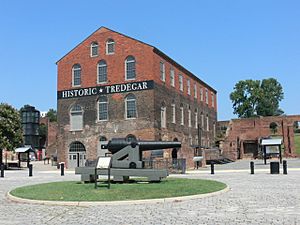
Today, the buildings at the Tredegar site have been saved and turned into a place to remember the Civil War. The site also hosts different festivals and public events, like the Richmond Folk Festival.
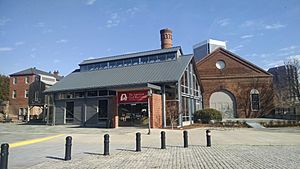
The Pattern Building is now the main visitor center for Richmond National Battlefield Park. The American Civil War Museum at Historic Tredegar is another museum located at the old ironworks.
Civil War Visitor Center at Tredegar Iron Works
The main visitor center for Richmond National Battlefield Park opened at Tredegar Iron Works in June 2000. This center is in the fixed-up Pattern Building. It has three floors of exhibits, a cool interactive map, a movie about the Civil War battles around Richmond, and a bookstore. Park rangers are there every day to help visitors and offer programs.
Lincoln Statue
In 2000, the old Tredegar Iron Works became the site of the main Visitor's Center for the Richmond National Battlefield Park. A sculptor named David Frech was asked to create a statue. It would remember the important visit of Abraham Lincoln and his son Tad Lincoln to Richmond on April 4, 1865. This was 10 days before Lincoln was assassinated.
The statue shows Lincoln and his son Tad sitting on a bench. The bench was made long enough so that visitors can sit next to them for photos. Behind them, the words "To Bind Up The Nation's Wounds" are carved into granite. These words are from Lincoln's Second Inaugural Address.
American Civil War Center at Historic Tredegar
The idea for another museum at the site became real in 2006. That's when the American Civil War Center at Historic Tredegar opened. Historian James M. McPherson said the museum was "a truly comprehensive exhibit and education center." It brings together the stories of Union, Confederate, and African-American people. The Center has interactive theaters, big screen maps, and old objects.
In November 2013, this Civil War Center joined with the Museum of the Confederacy. In January 2014, they became the American Civil War Museum.
See also





